Abstract
Objectives:
The main objective of the present investigation to develop and evaluate solid dispersions of BCS Class II drugs etoricoxib employing various natural polymers, compatible with conventional manufacturing method to enhance solubility of poorly soluble drugs.
Materials and Methods:
In this study, etoricoxib solid dispersion were prepared using xanthan gum, gaur gum and acacia and their combinations by solvent evaporation method. Solid dispersions and pure etoricoxib in the form of powder were characterized in comparison with pure drug and corresponding physical mixtures in the same ratios by Fourier transform infrared spectroscopy, differential scanning calorimetry (DSC), powder X-ray diffractogram, and in vitro drug release.
Results:
Solid dispersion (ET11) prepared with 1: 2: 2: 2 drug carrier ratios were showed highest solubility in different solvents. Hence the solid dispersion (ET11) of 1: 2: 2: 2 ratios were selected for characterization. The DSC study indicated that the crystalline nature of etoricoxib was reduced to amorphous. The diffraction pattern of the solid dispersions in each figure indicates that diffraction peaks at 2ɵ values has less intensity than that of pure drugs. This indicated that the crystalline nature of drug sample was converted to amorphous with ET11. Scanning electron microscope photographs of solid dispersion seem to be more porous in nature. From the in vitro drug release profile, it can be seen that formulation ETM11 shows higher dissolution rate i.e. 98.2±1.3% compared with other formulations. It is predicted that, increasing concentration of carrier, increases the drug dissolution rate.
Conclusion:
This study has shown that the solid dispersion of etoricoxib using natural carrier can be promising formulation for solubility and dissolution enhancement. Natural polymers used have shown promising results in the modification of drug release from the formulations.
Keywords: Etoricoxib, solid dispersions, Xanthan gum, guar gum, gum acacia
INTRODUCTION
Poorly water-soluble drugs are expected to have dissolution-limited absorption. Increasing drug solubility may contribute substantially to improved drug absorption and consequently drug bioavailability. There are several pharmaceutical strategies available to improve the aqueous solubility of poorly soluble drugs: solid dispersion, solubilization using surfactants, the use of cosolvents, reduction of particle size, hydrotrophy, and the use of aqueous soluble derivative or salts.1,2 Solid dispersion techniques have been used to enhance the dissolution and oral bioavailability of many poorly soluble drugs.3 One aspect of solid dispersion technology on which most researchers in the field would agree is that the number of marketed products arising from this approach has been disappointing. Indeed,the sheer simplicity of the manufacturing method, the fact that in general only the drug andcarrier are required, and the frequently reported improvements in both the dissolution rate andbioavailability would lead one to expect that the transfer to the marketplace would be rapid andwidespread. Research for alternative carriers has been increasing to suit the industrial applications as well as to reduce the production cost and toxic effects. Recently, many natural polymers have been evaluated for their use in new applications. The dissolution rate of drugs from formulations containing viscous carriers is generally low due to the formation of a gel layer on the hydrated surfaces, which prevents drug release during dissolution. This can be overcome during tablet formulation by adding disintegrants. Pulverization of the product is also another important drawback with the high viscosity carriers;it can be overcome by using a decreasing order of polymer/drug ratio during formulation.4,5 The poor aqueous solubility and wettability of etoricoxib, 5-chloro-6-methyl-3 [4-(methyl sulfonyl)phenyl]-2, 3-bypyridine, a highly selective second generation cyclooxygenage-2 inhibitor administered orally as an analgesic and nonsteroidal anti-inflammatory drug, cause difficulties in the formulation oforal dosage forms and lead to variable bioavailability.6 It is used in the treatment of rheumatoid arthritis, osteoarthritis, postoperative dental pain, chronic back pain, and acute gout. Moreover, recent studies have evidenced its efficacy in patients with ankylosing spondylitis. However, its very low aqueous solubility and poor dissolution can cause formulation problems and limit its therapeutic application by delaying the rate of absorption and the onset of action.7,8,9,10 Hence, enhancement of the solubility and/or dissolution rate of etoricoxib can be achieved by preparation of solid dispersions. Many authors have formulated solid dispersions of etoricoxib using a number of various polymers and methods. However, few attempts have been made to prepare solid dispersions of etoricoxib using natural polymers like xanthan gum, guar gum, and gum acacia as carriers to improve its aqueous solubility and dissolution. In the present study, a solvent evaporation technique was used to prepare solid dispersions with natural carriers, mainly xanthan gum, guar gum, and gum acacia and combinations of them. Solid dispersions and pure etoricoxib in the form of powder were characterized in comparison with pure drug and corresponding physical mixtures in the same ratios by Fourier transform infrared spectroscopy (FTIR), differential scanning calorimetry (DSC), X-ray powder diffractogram (XRPD), and in vitro drug release.
MATERIALS AND METHODS
Pure etoricoxib was a gift sample from Abbott Health Care Pvt Ltd, Mumbai, India. Xanthan gum, guar gum, and gum acacia were obtained from standard deviation (SD) Fine Chemicals, Mumbai. All other chemicals used were of analytical grade.
Ultraviolet-visible absorption spectroscopy11
A ultraviole (UV) spectrophotometer from Shimadzu, UV-1800, was used for all UV-visible spectroscopic studies. For the quantitative determination of the drug in various samples, the Beer-Lambertlaw was used. The first step was to create a standard calibration curve. To prepare a calibration curve the drug was dissolved in a suitable solvent. An aliquot was withdrawn from this and diluted. Various concentrations were made by serial dilution of this basic stock solution. The various solutions were measured, in triplicate, using UV-visible absorption spectroscopy to obtain absorption data. The data, which were the mean of the three readings obtained, were used to prepare a calibration curve. This curve was further used for the determination of the concentration of the drug in any formulation or during the dissolution studies.
Development of a calibration curve for etoricoxib
The stock solution of etoricoxib was accordingly diluted to obtain a concentration range of 0-10 µg/mL. The absorbance was observed against methanol as a blank and the calibration curve was plotted between concentration (x axis) and absorbance (y axis).
Partition coefficient determination of drug
Partition coefficient (oil/water) is a measure of a drug’s lipophilicity and an indication of its ability to cross cell membranes. It is defined as the ratio of un-ionized drug distributed between the organic and aqueous phases at equilibrium.
Po/w= (Coil/Cwater) equilibrium
The partition coefficient is commonly determined using an oil phase of octanol or chloroform and water. Drugs having values of P much greater than 1 are classified as lipophilic, whereas partition coefficients much less than 1 are indicative of a hydrophilic drug. Before the partition coefficient was determined, the phases of the solvent system were mutually saturated by shaking at the temperature of the experiment by the shake flask method for Po/w, in which an accurately weighed sample of etoricoxib (10 mg each) was taken in a conical flask containing a presaturated mixture of known quantities of high purity analytical grade n-octanol and double distilled water in 1:1 v/v ratio (25 mL:25 mL), which were then shaken for 100 rotations in 5 min and allowed to stand long enough again to allow the phases to separate. Afterwards the aqueous phase was sampled by a procedure that minimizes the risk of including traces of n-octanol by syringe. The quantity of substance present in the n-octanol phase was calculated by subtracting the quantity of substance in the aqueous phase from the quantity of the substance originally introduced. Finally, the partition coefficient was calculated using the equation. The same procedure was performed three times and the average Po/w was calculated.
Solubility determination and phase solubility study
The solubility of etoricoxib was determined by the equilibrium solubility method in which a saturated solution of the material was obtained by stirring an excess of drug in a constant quantity of solvent until saturation or equilibrium was achieved in a vortex mixer. Then it was filtered through Whatman filter paper (no.1) and concentration was analyzed by UV spectrophotometer at 284 nm. The solubility of etoricoxib was determined in distilled water and pH across the gastrointestinal tract, i.e. in pH 1.2, 4.5, and 6.8. Phase solubility studies of etoricoxib were carried out to evaluate the possible solubilizing effect of the carrier by adding an excess of drug to 10 mL of aqueous solutions containing increasing concentrations of gum acacia, guar gum, and xanthan gum (0%-2% w/v) and shaking at 25°C in a temperature controlled bath for 72 h. Drug concentrations were assessed spectrophotometrically.12
Preparation of solid dispersions and physical mixtures
Solid dispersions of etoricoxib were prepared using xanthan gum, guar gum, and gum acacia by the solvent evaporation method. A 1 g quantity of etoricoxib and natural carrier were dissolved separately in 100 mL of absolute ethanol. The solution was stirred for 1 h and the solvent was allowed to evaporate at room temperature. The solid dispersions obtained (ET1) were pulverized and sieved through 22 mesh and then stored in screw cap vials at room temperature pending further use. The same procedure was carried out for all the formulations presented in Table 1.
Table 1. Composition of etoricoxib solid dispersions.
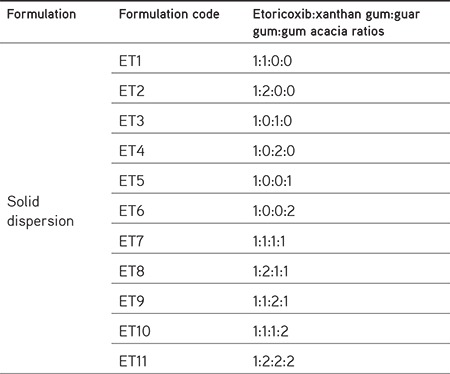
Physical mixtures of the etoricoxib and carriers having the same composition as the solid dispersions were prepared (ETM1) by simply triturating the drugs and the polymers in a porcelain mortar.13 The mixtures were sieved and stored in screw cap vials at room temperature pending further use. The same procedure was carried out for all the formulations presented in Table 2.
Table 2. Composition of etoricoxib physical mixture.

Determination of solubility of various solid dispersions
Etoricoxib loaded solid dispersions, physical mixtures, and pure etoricoxib equivalent to 30 mg were weighed and transferred to four flasks containing 50 mL of distilled water, pH 1.2 acetate buffer, phosphate buffer pH 6.8, and phosphate buffer pH 7.4. The sample was agitated at 80 rpm in a thermostated shaking water bath at 37±0.5°C for 8 h. The supernatant solution was then filtered through Whatman filter paper. The filtrate was diluted and the absorbance was measured using a UV-Vis spectrophotometer.12
Determination of percent yield
The percent yield of etoricoxib solid dispersions was determined according to the method described using the following expression:
Estimation of drug content of solid dispersions and physical mixtures
Solid dispersions equivalent to 60 mg of etoricoxib were weighed accurately and dissolved in a suitable quantity of methanol. The solutions were filtered through a membrane filter (0.45 mm). The drug content was determined at 284 nm by UV spectrophotometer after suitable dilution.14
Dissolution studies
The dissolution studies were performed using a US Pharmacopeia 24 type II dissolution test apparatus. Samples equivalent to 60 mg of etoricoxib were placed in a dissolution vessel containing 900 mL of phosphate buffer (pH 6.8) maintained at 37°C and stirred at 100 rpm. Samples were collected periodically and replaced with a fresh dissolution medium. After filtration through Whatman filter paper no. 41, the concentration of etoricoxib was determined spectrophotometrically at 284 nm. Dissolution studies were performed in triplicate (n=3) and the calculated mean values of cumulative drug release were used while plotting the release curves.
Fourier transform infrared studies
Compatibility studies of the drug (etoricoxib) with xanthan gum, guar gum, and gum acacia were carried out using FTIR spectroscopy. Sample from the drug alone, carrier alone, and physical mixture of drug and polymer was examinedby ATR sampling technique and the spectrum was scanned over the frequency range between 4000 and 600 cm-1 and at 4 cm resolution. The appearance, disappearance, or broadening of absorption band(s) on the spectra of the solid dispersions and the polymeric carriers in comparison with the spectrum of the drug were used to determine possible interactions between pure drug and polymers.
Differential scanning calorimetry
A Mettler Toledo DSC STARe systemwas used for all the DSC studies performed on the drug, polymer, physical mixtures, and solid dispersions. The DSC uses STARe software V8.10 for its operation. Samples ranging from 8 to 15 mg were used and the results were normalized using the software so that the results could be compared. The samples were placed in a 100 µL pan. The pans were covered with a lid and the lid was crimped into place. A pinhole was made in the lid to vent out any gas that might result while heating. The pan was then placed inside the furnace using an empty pan as a blank. The DSC was calibrated using indium (5-10 mg) with a melting onset temperature at 156±0.2°C and zinc with a melting onset temperature of 419.6±0.7°C as the standards. The two processes show a heat flow of 28.45±0.6 J/g and 107.5±3.2 J/g for indium and zinc, respectively.
Powder X-ray diffraction
Powder X-ray diffraction studies were performed to check for any crystallinity in the formulation after it was made and after the stability studies were performed. Avoiding recrystallization of the drug in the formulation was one of the goals of the present study. PAN analytical X-Pert Pro V1.6 with X Pert Data Collector V2.1 software was used equipped with a CuKa2 anode tube and diffractometer of radius 240 mm. The X-ray powder diffraction scan was performed using a BB004 flat stage. The powdered sample was placed in an aluminum sample holder that had a 2.5 cm square with a depth of 0.5 mm. The data were collected by scanning the sample at 45 kV and 40 mA. Samples were scanned from 5 to 50°C 2θ at a step size of 0.0170 and scan rate of 1.0°C/min.
Scanning electron microscopy
The surface morphology of the raw materials and the formulated product were studied using a scanning electron microscope equipped with a JEOL JSM 7500. Snappy 4 software was used to obtain the digital picture. Samples were placed on brass stubs using double-sided adhesive tape. The samples were coated with a layer of gold using a gold sputter technique to improve the conductivity of the surface of the sample to obtain good images. A Denton Vacuum Desk II was used for the gold sputter technique. Pictures were taken at magnifications whereby they could be compared with each other, showing best the surface features of the various materials.
RESULTS AND DISCUSSION
Preformulation studies of etoricoxib
The standard drug absorbance in methanol at 0 to 10 µg/mL concentration at 284 nm is reported in Table 3. The standard curve obeyed the Beer-Lambert law in the range of 0 to 10 µg/mL. Data in this range were subjected to linear regression analysis. The graphical presentation of the linear curve of etoricoxib in methanol is shown in Figure 1 and was linear.
Table 3. Standard absorbance of etoricoxib in methanol.
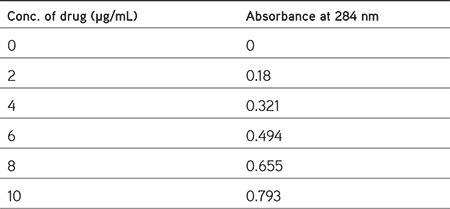
Figure 1.
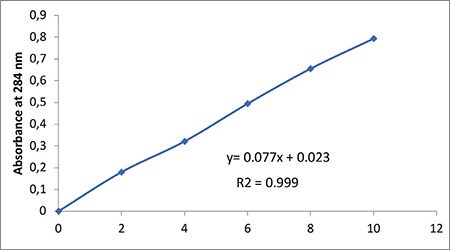
Standard calibration curve of etoricoxib
Correlation coefficient (R2)=0.999
Equation of regressed line: Y=0.0071x+0.023, where
X=value of concentration,
Y=Regressed value of absorbance.
In the preformulation study of the drug, the λ-maxof etoricoxib was found at 284 nm. Similarly the partition coefficient of etoricoxib was found to be 3.9 by the shake flask method, which indicates that it is lipophilic. Thus it can pass the cell membrane easily once solubilized.
Saturation solubility and phase solubility
The solubility data of etoricoxib in distilled water, acetate buffer pH 1.2, phosphate buffer pH 6.8, and phosphate buffer pH 7.4 at 25°C are given in Table 4. The comparison of etoricoxib in different solvents is presented graphically in Figure 2. The phase solubility curve of etoricoxib in the presence of natural carriers, i.e.xanthan gum, guar gum, and gum acacia, is shown in Figure 3. A systematic increase in the solubility of drug was observed with an increasing concentration of natural polymers in water. The increased solubility may be due to improved dissolution of drug in water by natural polymers. This might be due to the solubilization effect of carrier, which increased the wetting property of the drug. The data obtained from the phase solubility study are given in Table 5.
Table 4. Solubility data of etoricoxib in different solvents.

Figure 2.
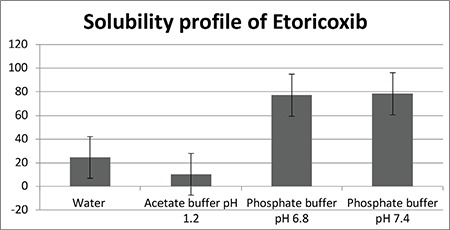
Solubility profile of etoricoxib
Figure 3.
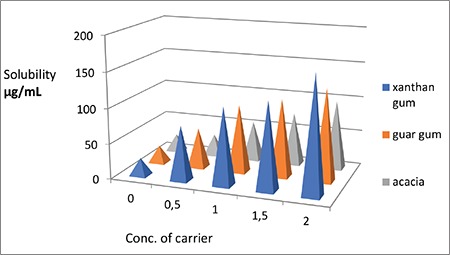
Phase solubility of etoricoxib with carrier
Table 5. Phase solubility data for etoricoxib in carriers.
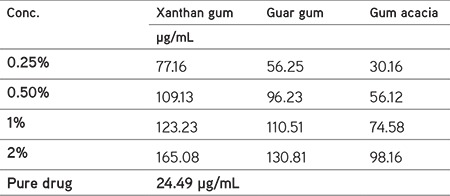
Solubility study of solid dispersions and physical mixtures
The solubility data of pure etoricoxibare shown in Table 4 and they indicated that 24.49 µg/mL pure etoricoxib was soluble in distilled water; hence it is considered a poorly water soluble drug. The solubility data of the physical mixtures containing etoricoxib and xanthan gum, guar gum, and gum acaciaare shown in Table 6. The solubility profile of the physical mixtures of etoricoxib is shown in Figure 4. The solubility of etoricoxib in the solid dispersions prepared by solvent evaporation in different solvents was also studied and the data for the same are given in Table 7. As compared to pure drug and the physical mixtures, the solid dispersions prepared by solvent evaporation showed higher solubility in distilled water, pH 1.2 acetate buffers, phosphate buffer pH 6.8, and phosphate buffer pH 7.4 (Figure 5). The present investigation suggested thatthis might be possible due to the preparation of solid dispersions using varying concentrations of natural carriers, which formed a eutectic mixture and increased the wettability of etoricoxib and hence its solubility.
Table 6. Solubility of physical mixture of etoricoxib and xanthan gum, guar gum, and gum acacia.
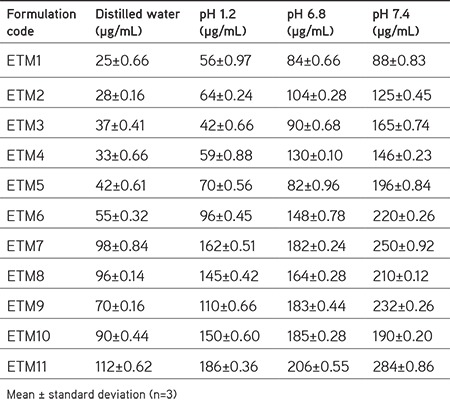
Figure 4.
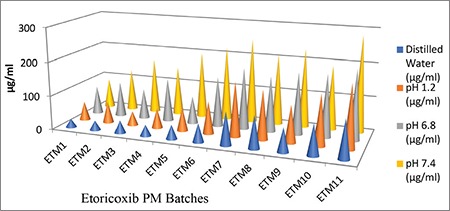
Solubility profile of etoricoxib physical mixture
Table 7. Solubility of solid dispersion of etoricoxib and xanthan gum, guar gum, and gum acacia.
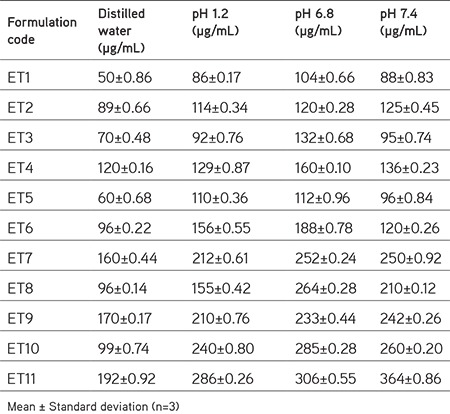
Figure 5.
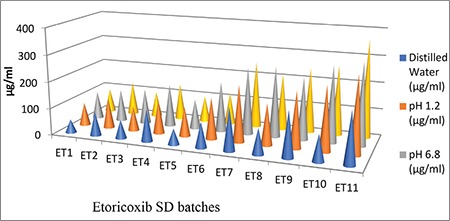
Solubility profile of etoricoxib solid dispersion
Percentage yield of solid dispersions
Etoricoxib solid dispersion with xanthan gum had a yield of 90.5% and 91.8% for the etoricoxib:xanthan gum combination ratios of 1:1 and 1:2 (ET1 and ET2), respectively. The yield recorded for etoricoxib:guar gum solid dispersions at ratios of 1:1 and 1:2 was 94.2% and 96.4% (ET3 and ET4), respectively. Solid dispersion of etoricoxib with gumacacia at a ratio of 1:1 and 1:2 had yields of 93.0% and 98.12% (ET5 and ET6), respectively. Solid dispersion of etoricoxib with xanthan gum, guar gum, and gum acacia at a ratio of 1:1:1:1 had a yield of 97.10% (ET7). Solid dispersion of etoricoxib with xanthan gum, guar gum, and gumacacia at a ratio of 1:2:1:1 had a yield of 98.2% (ET8). Solid dispersion of etoricoxib with xanthan gum, guar gum, and gum acacia at a ratio of 1:1:2:1 had a yield of 96.0% (ET9). Solid dispersion of etoricoxib with xanthan gum, guar gum, and gum acacia at a ratio of 1:1:1:2 had a yield of 94.0% (ET10). Solid dispersion of etoricoxib with xanthan gum, guar gum, and gum acacia at a ratio of 1:2:2:2 had a yield of 93.0% (ET11) (Table 8) (Figure 6).
Table 8. Percent yield of etoricoxib solid dispersion.
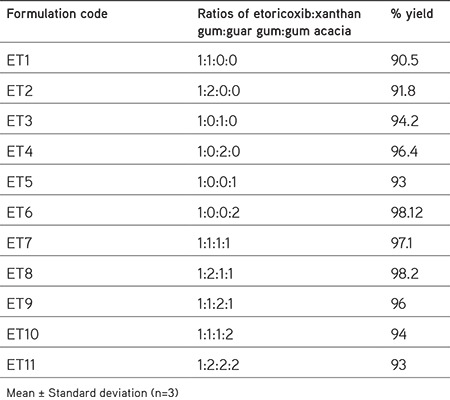
Figure 6.
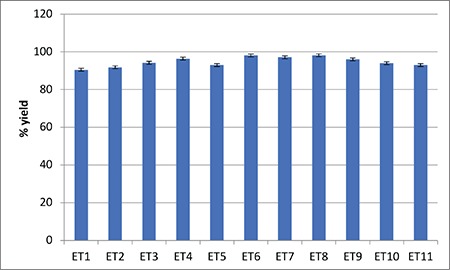
Effect of composition of polymers on yield of etoricoxib solid dispersion
Drug content of solid dispersions and physical mixtures
A fundamental quality attribute for all pharmaceutical preparations is the requirement for a constant dose of drug between dispersions. In each of the mentioned formulae, no single preparation found outside thelimit. All the formulations and physical mixture contained active ingredients within the general limit of 90%-110%. Etoricoxib content (%) with xanthan gum, guar gum, and gum acacia in physical mixture and solid dispersion with different drug:carrier ratios is shown in Table 9 and Table 10, respectively. The entire percent drug shown in the tables was found within the general specification. It is proved that the formulation prepared can be continue for further evaluation.
Table 9. Drug content of etoricoxib solid dispersion.
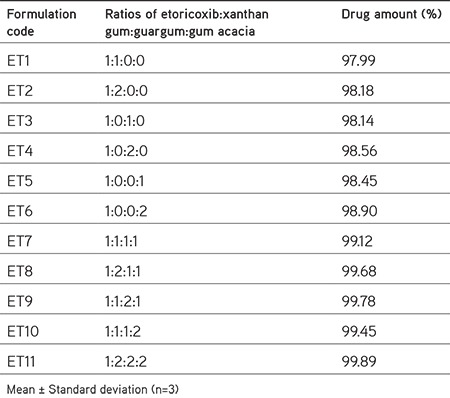
Table 10. Drug content of etoricoxib physical mixture.
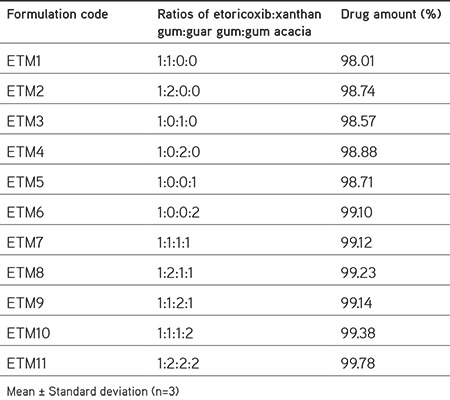
In vitro dissolution study of solid dispersions and physical mixtures of etoricoxib using natural carrier
Dissolution studies were performed to compare the drug release from the physical mixtures and solid dispersions to that of the pure drug etoricoxib. The dissolution test was carried out for a period of 90 min in pH 6.8 phosphate buffer. The drug release data obtained for formulations ETM1-ETM11 are tabulated in Table 11. They show the cumulative percent drug released as a function of time for all formulations. The cumulative percent drug released after 90 min is shown in the table. In vitro studies reveal that there is a marked increase in the dissolution rate of etoricoxib from all the physical mixtures when compared to pure etoricoxib itself. From the in vitro drug release profile, it can be seen that formulation ETM11 containing etoricoxib, xanthan gum, guar gum, and gum acacia (1:2:2:2) shows a higher dissolution rate, i.e. 98.2±1.3%, compared with the other formulations. It is predicted thatan increasing concentration of carrier will increase the drug dissolution rate. The dissolution profile of the physical mixture of etoricoxib, xanthan gum, guar gum, and gum acacia over the period of 1.5 h is shown in Figure 7.
Table 11. Drug release profile of physical mixtures of etoricoxib using natural carrier.
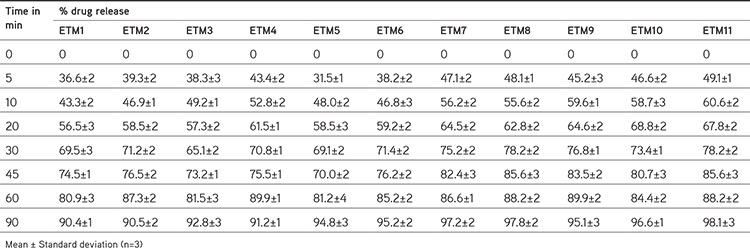
Figure 7.

Drug release pattern of physical mixtures of etoricoxib using natural carrier
The percentage of drug released from the solid dispersions of etoricoxib using natural carrier is shown in Table 12. As compared to the physical mixtures of etoricoxib with natural carrier, the solid dispersions showed a higher dissolution rate for etoricoxib. Over the period of 90 min, a maximum of 98% drug was released.The percent drug released increased with increasing concentration of carrier. The increase in dissolution of etoricoxib from the solid dispersions might be attributed to factors such as a reduction in the particle size of the drug in the matrix, increase in the surface area, reduced crystallinity, and an increase in the solubility of the drug in the presence of the lipid carriers. The drug release is shown in Figure 8. The literature reveals that the solvent evaporation method of solid dispersion solubilizes the drug and carrier at molecular level,hence forming a eutectic mixture and increasing the solubility of poorly water soluble drugs.
Table 12. Drug release profile of solid dispersions of etoricoxib using natural carrier.
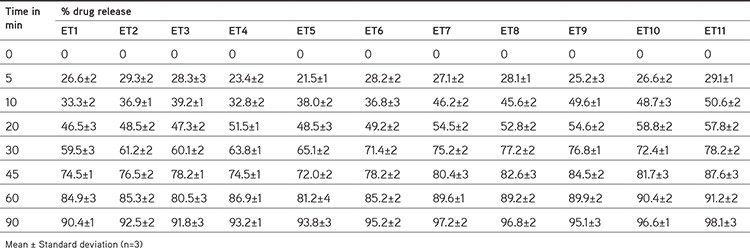
Figure 8.
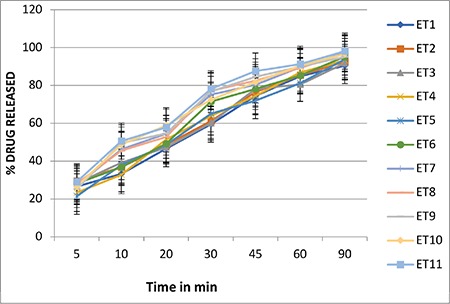
Drug release pattern of solid dispersions of etoricoxib using natural carrier
FTIR spectral studies
The infrared spectrum of etoricoxib is shown in Figure 9. The characteristic peaks of functional groups present in the drugs were checked and are given in Table 13. The functional groups present in the structure of etoricoxib were identified correctly and hence the drug was confirmed and considered for further uses.
Figure 9.
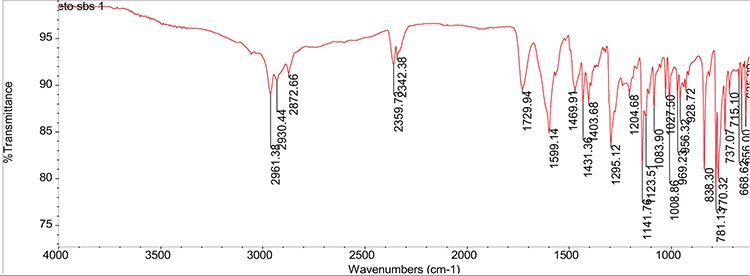
Infrared spectrum of etoricoxib
Table 13. Characteristic peaks of etoricoxib.

The IR spectra of pure etoricoxib showed characteristic peaks at 1596.9 cm-1 (C=N stretching vibration); 1431 cm-1, 1300 cm-1, 1141.8 cm-1, and 1085.8 cm-1 (S=O stretching vibrations); and 840.9 cm-1, 775.3 cm-1, and 638 cm-1 (C-Cl stretching vibrations), respectively (Figure 9). Figures 10, 11, and 12 show theinfrared spectrum of xanthan gum, guar gum, and gum acacia, respectively. From the spectrum it was observed that chemical groups C=N stretching vibration, S=O stretching vibrations, and C-Cl stretching vibrationshad the same wave number as etoricoxib did (Figure 13).
Figure 10.
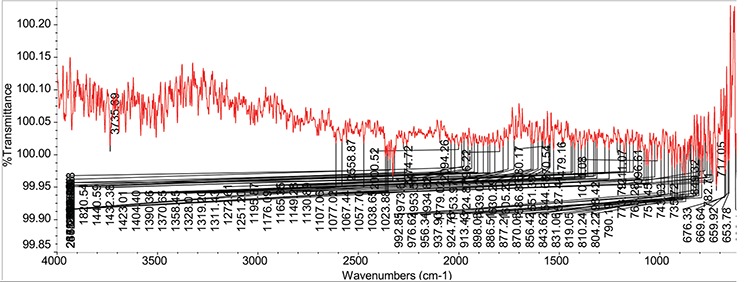
Infrared spectrum of xanthan gum
Figure 11.
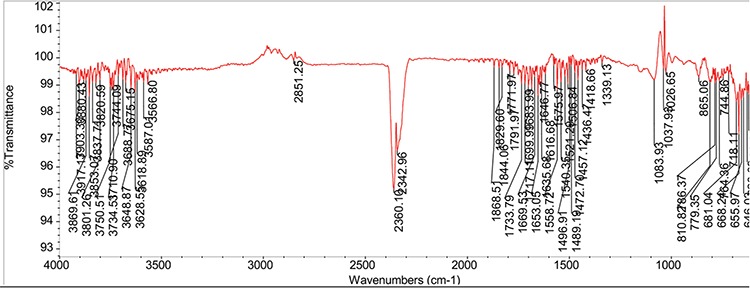
Infrared spectrum of guar gum
Figure 12.
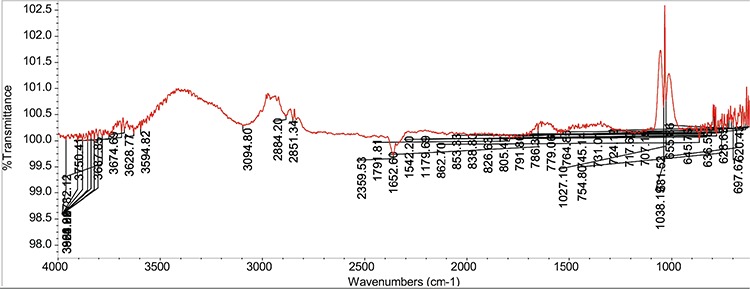
Infrared spectrum of gum acacia
Figure 13.
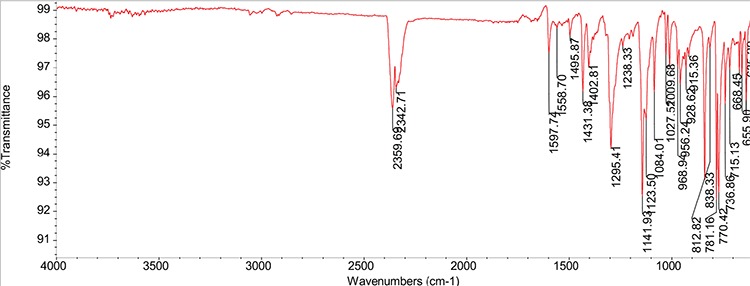
Infrared spectrum of etoricoxib and carrier mixture
DSC studies
The DSC thermogram of etoricoxib, xanthan gum, guar gum, and gum acacia and its solid dispersion ET11 (1:2:2:2) is shown in Figure 14. The DSC thermogram of pure etoricoxib shows a single sharp endothermic peak at 140.05°C, indicating that the drug is highly crystalline. The DSC thermogram of the solid dispersion of etoricoxib showed a shallow endothermic peak at 74.88°C, indicating glass transition temperature, a recrystallization peak at 112°C, and a melting peak at 132°C. This confirmed the transformation of crystalline etoricoxib into amorphous etoricoxib and hence improved dissolution. The physical mixture of etoricoxib and xanthan gum, guar gum, and gum acacia did not show such change in Figure 15.
Figure 14.
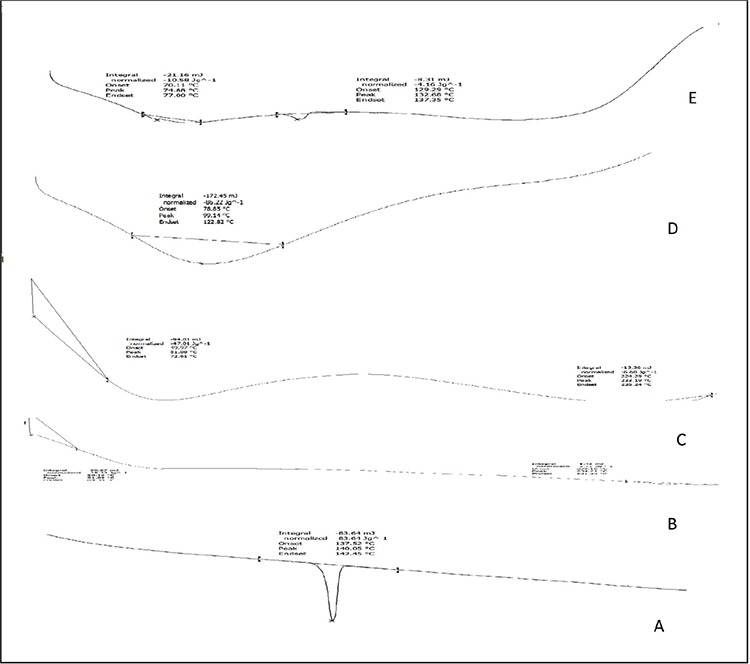
Differential scanning calorimetry thermogram of A) etoricoxib, B) gum acacia, C) guar gum, D) xanthan gum, and E) etoricoxib and xanthan gum, guar gum, and gum acacia solid dispersion
Figure 15.

Differential scanning calorimetry thermogram ofetoricoxib and xanthan gum, guar gum, and gum acacia physical mixture
XRPD studies
The XRPD pattern of etoricoxib, xanthan gum, guar gum, and gum acacia and solid dispersion ET11 is shown in Figure 16. The XRPD patterns of pure etoricoxib showed numerous distinctive peaks in the region of 10 to 50° (2ɵ), i.e. 17°, 18.2°, 24.2°, and 29.2°, indicating the crystalline nature of etoricoxib. The XRPD study of etoricoxib solid dispersion (ET11) indicated a halo pattern. It showed broad and diffuse maxima attributable to the relatively random arrangement of the constituent molecules, which produced poorly coherent scatters. These patterns were quite distinct from those produced by the crystalline etoricoxib. This confirmed the transformation of crystalline etoricoxib into amorphous etoricoxib and was also supported by DSC results. The enhancement in the dissolution rate of the drug from the solid dispersion is ascribed to the marked reduction in the crystallinity of the drug.
Figure 16.
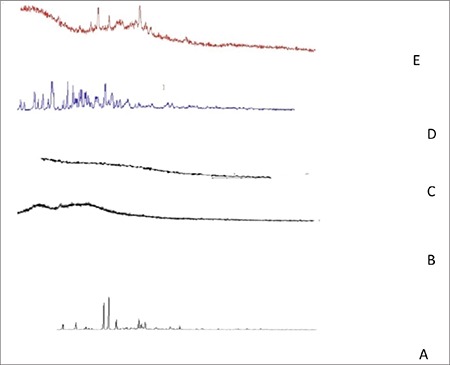
X-ray powder diffractionof A) etoricoxib, B) gum acacia, C) guar gum, D) xanthan gum, and E) etoricoxib and xanthan gum, guar gum, and gum acacia solid dispersion
Scanning electron microscopy studies
Scanning electron microscopy (SEM) photographs for pure drug and optimized formulation ET11 are shown in Figures 17 and 18, respectively. It was found that the presence of polymer in the solid dispersion influenced the particle size of the resultant agglomerates. The size of the particles increased with an increase in deposition of polymer on the surface of the drug. The surface morphology studies revealed that the solid dispersion was closely compacted into small spherical form.
Figure 17.
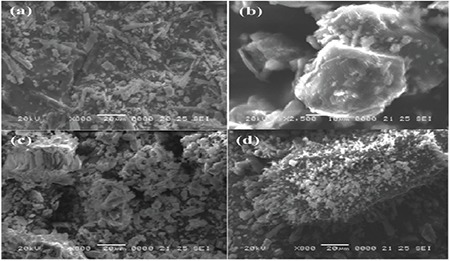
Scanning electron microscopy of A) etoricoxib, B) gum acacia, C) gaur gum and, D) xanthan gum
Figure 18.
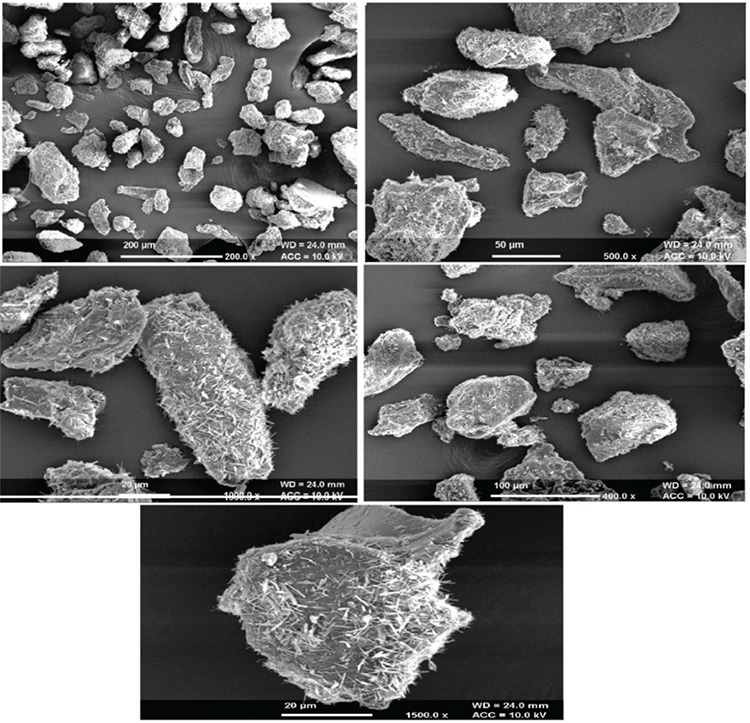
Scanning electron microscopy study of etoricoxib solid dispersion using natural carrier
CONCLUSION
In the present study it was clearly demonstrated that etoricoxib solid dispersion formulation can be effectively produced by processing via solvent evaporation with enhanced solubility and dissolution rates. Natural polymer combinations were optimized and stable solid dispersion systems were developed successfully. Utilization of xanthan gum, guar gum, and gum acacia offers excellent possibilities to develop stable amorphous solid dispersions. Furthermore, this etoricoxib incorporated solid dispersion gave higher dissolution and solubility values compared to the pure etoricoxib drug. In vitro drug release studies of optimized formulation ET11 exhibited a cumulative release of 98.1±3% after 90 min. The FTIR spectrum revealed that no chemical interaction occurred between the drug and excipients used in the formulation. Analysis by DSC and powder X-ray diffraction showed that etoricoxib existed in amorphous form within the solid dispersion formulation fabricated using the solvent evaporation process. Additionally, scanning electron microscopy studies suggested the conversion of crystalline etoricoxib to an amorphous form. The dissolution rate and solubility of etoricoxib solid dispersions were improved significantly using the natural carriers xanthan gum, guar gum, and gum acacia.
Acknowledgments
The authors are grateful to Abbott Health Care Private Limited (India) for providing etoricoxib as a gift sample.
Footnotes
Conflicts of interest: No conflict of interest was declared by the authors.
References
- 1.Amidon GL, Lennernäs H, Shah VP, Crison JR. A theoretical basis for a biopharmaceutical drug classification: Correlation of in vitro drug product dissolution and in vivo bioavailability. Pharm Res. 1995;12:413–420. doi: 10.1023/a:1016212804288. [DOI] [PubMed] [Google Scholar]
- 2.Ain S, Ain Q, Parveen S. An overview on various approaches used for solubilization of poorly soluble drugs. Pharm Res. 2009;2:84–104. [Google Scholar]
- 3.Habib MJ. Pharmaceutical solid dispersion technology. CRC, New York. 2000. [Google Scholar]
- 4.Murali Mohan Babu GV, Prasad ChD, Ramana Murthy KV. Evaluation of modified gum karaya as carrier for the dissolution enhancement of poorly water soluble drug nimodipine. Int J Pharm. 2002;234:1–17. doi: 10.1016/s0378-5173(01)00925-5. [DOI] [PubMed] [Google Scholar]
- 5.Sapkal S, Narkhede M, Babhulkar M, Mehetre G, Rathi A. Natural polymers: Best carriers for improving bioavailability of poorly water soluble drugs in solid dispersion. Marmara Pharm J. 2013;17:65–72. [Google Scholar]
- 6.Leclercq P, Malaise MG. Etoricoxib (Arcoxia) Revue Medicale de Liege. 2004;59:345–349. [PubMed] [Google Scholar]
- 7.Capone ML, Tacconelli S, Patrignani P. Clinical pharmacology of etoricoxib. Expert Opin Drug MetabToxicol. 2005;1:269–282. doi: 10.1517/17425255.1.2.269. [DOI] [PubMed] [Google Scholar]
- 8.Cochrane DJ, Jarvis B, Keating GM. Etoricoxib. Drugs. 2002;62:2637–2651. doi: 10.2165/00003495-200262180-00006. [DOI] [PubMed] [Google Scholar]
- 9.Patel DM, Patel MM. Optimization of fast dissolving etoricoxib tablets prepared by sublimation technique. Indian J Pharm Sci. 2008;70:71–76. doi: 10.4103/0250-474X.40335. [DOI] [PMC free article] [PubMed] [Google Scholar]
- 10.Patel HM, Suhagia BN, Shah SA, Rathod IS, Parmar VK. Preparation and characterization of etoricoxib-β-cyclodextrin complexes prepared by the kneading method. Acta Pharm. 2007;57:351–359. doi: 10.2478/v10007-007-0028-2. [DOI] [PubMed] [Google Scholar]
- 11.Shavi GV, Nayak UY, Raghavendra R, Shrawan B, Sreenivasa Reddy M. Enhanced Dissolution and Bioavailability of Etoricoxib in Solid Dispersion Systems: An Investigation into the Role of Carrier Matrix on Stability, In vitro and In vivo Performance. RRJPPS. 2016;5:55–63. [Google Scholar]
- 12.Higuchi T, Connors KA, Phase solubility techniques. Adv Anal Chem Instrum. 1965;4:117. [Google Scholar]
- 13.Rao M, Mandage Y, Thanki K, Bhise S. Dissolution improvement of simvastatin by surface solid dispersion technology. Dissolution Technologies. 2010:27–34. [Google Scholar]
- 14.Ketkar AR, Patil VB, Paradkar AR. Computer Aided Exploratory Data Analysis Model Fitting for Dissolution Kinetics. 4th International Symposium on Advances in Technology and Business Potential of New Drug Delivery System. Mumbai, India. 2002. [Google Scholar]


